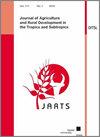Are there gender differences in access to and demand for East Coast fever vaccine? Empirical evidence from rural smallholder dairy farmers in Kenya
Q3 Social Sciences
Journal of Agriculture and Rural Development in the Tropics and Subtropics
Pub Date : 2020-11-03
DOI:10.17170/KOBRA-202010191970
引用次数: 4
Abstract
Women lag in the adoption of agricultural innovations compared to men, mainly due to gender inequalities in access to complementary inputs, capital, and knowledge/information. The Infection-and-Treatment-Method (ITM) is considered a safe and effective method of controlling East Coast fever. However, since its commercialisation in Kenya differences in demand for this vaccine among smallholder men and women dairy cattle keepers have not been assessed. Using a sample of 448 respondents, we used an Average-Treatment-Effect framework to estimate ITM adoption rates under awareness constraints and the determinants of adoption among smallholder male-headed (MHHs) and femaleheaded (FHHs) households. We found some difference in ITM awareness between MHHs (57 per cent) and FHHs (46 per cent). However, gender adoption gaps in the actual and potential adoption rates were considerable, with actual adoption rates of 41 per cent and potential adoption rate of 62 per cent among MHHs, compared to 19 per cent actual and 31 per cent potential adoption for FHHs. The smaller adoption gap for FHHs indicates that only increasing awareness amongst FHHs will not reduce inequities. ITM adoption in both household headships was mainly determined by education, extension interventions, access to financial services, and social capital. In addition to this, ITM adoption in FHHs was positively influenced by age, land-size, and group membership. To realise adoption beyond the current potential and to reduce inequities at the scale-up stage, gender-specific interventions targeting resource-poor women cattle keepers would be effective, in addition to ensuring that women have access to extension and financial services.在获得和需求东海岸热疫苗方面是否存在性别差异?来自肯尼亚农村小奶农的经验证据
与男性相比,女性在采用农业创新方面落后于男性,主要原因是在获得补充性投入、资本和知识/信息方面存在性别不平等。感染治疗法(ITM)被认为是一种安全有效的控制东海岸热的方法。然而,自从该疫苗在肯尼亚商业化以来,还没有评估过男女奶牛饲养者对该疫苗的需求差异。利用448名受访者的样本,我们使用平均处理效果框架来估计在意识约束下的ITM采用率,以及在小农男性户主(MHHs)和女性户主(FHHs)家庭中采用率的决定因素。我们发现MHHs(57%)和FHHs(46%)在ITM意识上存在一些差异。然而,实际和潜在采用率的性别差距相当大,卫生保健机构的实际采用率为41%,潜在采用率为62%,而家庭卫生保健机构的实际采用率为19%,潜在采用率为31%。FHHs的采用差距较小表明,仅提高FHHs的认识并不能减少不平等现象。两家户主对ITM的采用主要取决于教育、推广干预、获得金融服务和社会资本。除此之外,FHHs的ITM采用受到年龄、土地面积和群体成员的积极影响。为了实现超越现有潜力的采用,并在扩大阶段减少不平等现象,除了确保妇女获得推广和金融服务外,针对资源贫乏的女养牛人的性别干预措施将是有效的。
本文章由计算机程序翻译,如有差异,请以英文原文为准。
求助全文
约1分钟内获得全文
求助全文
来源期刊
CiteScore
2.30
自引率
0.00%
发文量
0
审稿时长
>36 weeks
期刊介绍:
The Journal of Agriculture and Rural Development in the Tropics and Subtropics publishes papers dealing with original research and review papers in the fields of plant production, animal nutrition and animal husbandry, soil science, rural economy and farm management, forestry and forest economy, veterinary hygiene and protection against epidemics.

 求助内容:
求助内容: 应助结果提醒方式:
应助结果提醒方式:


